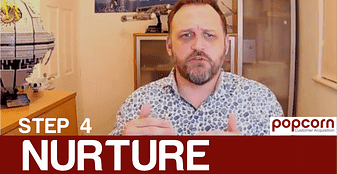FREE Training:
How to Convert Social Media Contacts into Customers
Step 1 - POST
In the first section of PRM-NOW, I’m going to show you how to get your content right using the principle of PRM. Approaching each post as a conversation will entice more engagement that goes beyond the initial interest.
You’re a business, you need to post on social media, and you need to post well. But you don’t have a clue how to. When thinking about prospect relationship management, it gets a little deeper.
Why
The first thing you need to figure out is why you want to post. The obvious answer is, of course, brand awareness: you want people to know you so they know they can buy from you. Engagement at this point is key, as 60% of a sales decision is made before reaching out to a sales person. By identifying when an individual starts to engage, you can influence their buying decision.
Under the umbrella of brand awareness, PRM encourages you to use social media a little more proactively. Instead of shouting into the void, you’re talking to an audience with an interest in your cut of the industry. Having conversations—direct replies, polls, feedback—gets accompanied by thoughtful, sculpted and niche content that the right sort of person wants to engage with. This is the ultimate goal: you’re posting for future prospects, not just any old audience.
Where
Making people aware of your brand requires your brand to be reachable. This means you’ve got to put yourself out there—wherever there is. Which platforms you prioritise is down to what industry you’re part of: creatives and freelancers, particularly those in media, prioritise Instagram and Twitter. Academics also prioritise Twitter for its connections. Commerce and retail, particularly local businesses, use Facebook as their first point of call. LinkedIn, understandably, is the place for recruiters. You’ll need to see where your industry congregates most, but it’s highly likely they will have a presence across the board.
This matters because each platform has different rules about the content that works. Although your brand needs to be consistent, you need to manipulate the tone slightly as well. Your business’ Facebook page is generally more strait-laced. Instagram is the best way to display your visual content, through posts and stories. LinkedIn requires a professional tone, and encourages engagement with others in the industry. But on Twitter, you can let loose a little more with your tone; you can have fun and have a joke. You are viewed as an equal with the rest of Twitter—your audience will say exactly what’s on their mind, and you can work with that to great effect.
Join over 7,000 small businesses to get monthly tips on nurturing your prospects
What
The second thing you need to figure out is what you want to post. It’s easy to fall at the first hurdle here: social media is another opportunity to sell, yes, but people don’t appreciate it when they know they’re being sold to. So don’t put on your sales voice—put on your brand voice. The idea of engagement is to engage, not stand on a soapbox and demand people listen.
As mentioned above, the PRM approach asks you to converse, not just announce. Post content that gets people talking. Encourage asking questions—and answer them, quickly. A standoffish reputation will only lead to diminished sales.
When
It is not just where you post that demands a curated approach. When you post has a huge effect on how much engagement you’re going to get. And this can change on the platform, too, so you need to be in the know to get the most out of your marketing efforts.
Luckily, it’s easy to search for when to post depending on your industry, and there are plenty of articles keeping this information up to date with the world. There are some general industry indications, but if you need more specific information, then lean on any contacts you have or test and measure times and days to see what gets the best response. Sometimes, the least likely times can be the best!
However, there is one fact that holds true across all social media: you have to post, and keep posting. The world of social media is ultra-fast, and any post has the potential to seem ‘temporary’ even if it stays on your account forever (this is especially true of Twitter). Keeping up a steady level of content reminds people that you still exist, and that you’re still relevant. Forgetting to post for days, or even hours, means you’ll miss out on prospects who otherwise would’ve caught you at the right time.
Basic Engagement vs Direct Engagement
So you’ve got the ball rolling, posting consistent content, but there’s no real engagement aside from a couple of likes, retweets and reposts. These “vanity measures” are not turning into conversions.
This is the problem of basic engagement versus direct engagement. This may be because of a number of factors: people are using your content for information, research, but not anything else. They may return to a previous supplier because of familiarity.
The messaging may be split across different platforms and so get lost in the noise. You might not be directing onlookers onto the right pages.
Alternatively, your content might not encourage people to respond and interact further. Exposure is not the same as response.
This, of course, means you can lose out on vital conversations that would have developed into conversions.
Keep Them Coming
Consistency is key. Make sure you’re posting across all platforms, even if you’re focusing on one platform because of your industry’s presence on there.
A great way to ensure your content is consistent is by using scheduling tools, such as HootSuite or Sprout Social, to schedule your posts days or even weeks in advance. This way, you always seem online and on the ball, even if you’re busy with other jobs.
But more than that, you can combat the basic engagement vs direct engagement problem by diversifying your content.
Links to your website can do the job, but what about events in your industry? Or any big industry news that is worth sharing? Having an opinion, or even just spreading the news further, can go a big way into solidifying your brand as a voice to listen to. Sharing tips, videos and creating blog posts, solidifies this vital aspect of your brand’s image further.
Taking a break from talking about the industry, as well, is a great way to humanise your brand and show off your personality. Being witty, or dry, can score appreciation with your followers. Asking questions that people want to reply to, or making polls, go a long way to bolster direct engagement. Tagging people you know will appreciate your content gives the impression of being active, and plus people in further. Plus, this satisfies the PRM approach: you are deliberately reaching out to people, and viewing them as the individuals. You fine-tune your content to suit them, not you. If people feel listened to, they feel appreciated, and this will develop the trust between you and your prospect.
Making the most of the holidays throughout the year—calendar holidays such as Chinese New Year, or national days like #NationalDoughnutDay—can inject some fun into a company page. (Sensitivity to the topic at hand is, of course, necessary. Don’t jump on an issue-based topic if it has no bearing on your company, your life or you don’t believe in it.)
Conclusion
Ultimately, it is up to you what you post and how you go about it. But by sticking to your objective and making the most of what social media can give you, you can turn an okay social media strategy into one that delivers prospects right to your doorstep.
Discover the steps to PRM NOW
Step 1 – POST (4 mins)
‘NURTURE’ is about cultivating your leads, so that the opportunities stand out.
Step 2 – REACT (5 mins)
‘REACT’ discusses how to drive more ‘POST’ engagement and how to identify time wasters and real prospects.
Step 1 – MANAGE (3 mins)
‘MANAGE’ is a vital part of converting your Social Media Contacts whilst ensuring that leads are not missed.
Step 4 – NURTURE (4 mins)
‘NURTURE’ is about cultivating your leads, so that the opportunities stand out.
Step 5 – OPPORTUNITY (5 mins)
‘OPPORTUNITY’ goes though how to turn all the opportunities and successfully spot the HOT prospects.
Step 6 – WON (6 mins)
Now you’ve “WON” the customer, what should you do to turn them into advocates?
Ready to get started with popcorn Lead Management?
*FREE 5 Day Trial of popcorn CRM, then £5+VAT per month. No Set-Up Fees, No Contracts, No Hidden Costs













